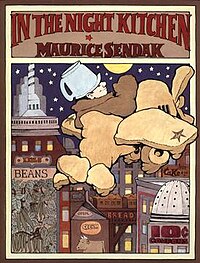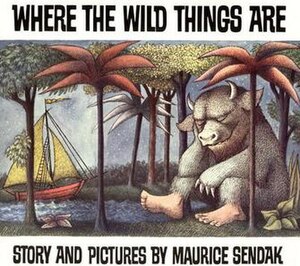Welcome to the de Grummond Collection
| |
| The de Grummond Children's
Literature Collection is one of North America's leading research centers in the
field of children's literature. Although the Collection has many strengths, the
main focus is on American and British children's literature, historical and
contemporary. Founded in 1966 by Dr. Lena Y. de Grummond, the Collection holds
the original manuscripts and illustrations of more than 1200 authors and
illustrators, as well as 120,000+ published books dating from 1530 to the
present. Part of Special Collections,
the de Grummond Collection is housed in the McCain Library and Archives on the
campus of The University of Southern
Mississippi. Under their Research tab, I came across a reference to Minnesota which surprised me (emphasis in bold added - mine, DG): Censorship Bibliography Memories of Childhood: Six Centuries of Children’s Literature at the de Grummond Collection In the Night Kitchen by Maurice Sendak, Harper & Row, 1970. Challenged in Illinois, Texas, New Jersey because of nudity. Challenged in the Elk River, Minnesota schools in 1992 “because reading the book could lay the foundation for the future use of pornography.” |
Like these - the one of the kid in the rose petals is a little boy named Jake.
Among the other books listed in the de Grummond list of censored books were all of the Harry Potter books, and one of my childhood favorites, "A Wrinkile in Time" by Madeleine L'Engle. Apparently in Texas they are afraid their children are too easily confused, and might start to think instead of blindly believing in Christianity like good stupid conservatives. In the Night Kitchen won a Caldecott Honor; A Wrinkle in Time won the Newbery Medal, the Sequoya Book award, the Lewis Carroll Shelf award, and was a runner up for the Hans Christian Andersen award. In other words, these are recognized works of quality, but like the protest of the Disney movie Aladdin by Michele Bachmann back in the day, these are frightening to people who embrace ideas, who embrace freedom instead of free-dumb.
Apparently there were parts of the country that engaged in the primitive, ludicrous effort of bowdlerizing. They commissioned artists to paint over the few pages of Maurice Sendak's books with marker, or putting in diapers with correction fluid, rather than allow showing Mickey, the protagonist, as God would have made him if he were not a character of fiction. I can only shudder to think what these same people do to Ann Geddes' photos. These prudes, these ignorant, fearful, well meaning conservative people are an embarrassment to Minnesota.
Sad news from MSNBC.com :
‘Where the Wild Things Are’ author Maurice Sendak dead at age 83
Children’s author and illustrator reportedly died of complications from a stroke
TODAY books
Maurice Sendak, the children’s author and illustrator best known for the 1963 classic “Where the Wild Things Are,” died Tuesday in Danbury, Conn., reportedly of complications from a stroke. He was 83.
The Brooklyn-born author, the son of Jewish immigrants from Poland, lost many family members in the Holocaust and spent time in bed with health problems as a child. After seeing the Disney movie “Fantasia” at the age of 12, an experience that influenced his work throughout his career, he decided to become an illustrator.
Video: ‘Wild Things’ author Maurice Sendak dead at 83 (on this page)Career of controversyDuring the 1950s, Sendak illustrated children’s books by other authors before starting to write his own stories, most notably the "Little Bear" series by Else Holmelund Minarik. His first solo work was "Kerry's Window" in 1956.
Video: ‘Wild Things’ author Maurice Sendak dead at 83 (on this page)Career of controversyDuring the 1950s, Sendak illustrated children’s books by other authors before starting to write his own stories, most notably the "Little Bear" series by Else Holmelund Minarik. His first solo work was "Kerry's Window" in 1956.
2009: ‘Wild Things’ author isn’t wild about Hollywood
Sendak wrote and illustrated many other books, including the controversial 1970 work “In the Night Kitchen,” about a boy who dreams of helping a baker create a cake in a bizarre kitchen. The book's hero, Mickey, is naked in illustrations throughout the book, and it has frequently been challenged and banned. Other Sendak works include “Outside, Over There” (1981), the story of a girl who is left to care for her younger sister and reluctantly goes to her rescue when the child is abducted by goblins.
Sendak's work extended beyond printed media. He was an advisor to the Children's Television Workshop during the initial development of "Sesame Street" and worked on several animated stories for the show, including an adaptation of his book "Bumble-Ardy." In 1975 he produced an animated TV special, "Really Rosie," which featured the voice of Carole King. Inspired by a little girl Sendak observed singing and dancing outside during his childhood in Brooklyn, "Really Rosie" has become a staple of children's theater troupes.
Video: 1980: Sendak talks about ‘Wild Things’ ‘Really Rosie’ (on this page)Sendak created a stage version of "Where the Wild Things Are" in 1979 and designed opera and ballet sets for such groups as Houston Grand Opera and the New York City Opera. He also collaborated with "Angels in America" playwright Tony Kushner on an English version of the Czech children's opera "Brundibar"; his illustrated book version, featuring text by Kushner, was named one of the 10 best illustrated books of 2003 by the New York Times Book Review.
Accolades and remembrancesIn addition to his Caldecott Medal for "Where the Wild Things Are," Sendak's many accolades include a 1970 Hans Christian Andersen Award for children's illustration, a 1982 National Book Award for "Outside Over There," a 1983 Laura Ingalls Wilder Medal, and a 2003 Astrid Lingren Memorial Award.
Video: 2006: Maurice Sendak on latest kid's book (on this page)
Sendak lived with psychoanalyst Eugene Glynn for 50 years before Glynn's death in 2007.
Among those mourning Sendak's passing are a number of mothers who commented on the TODAY Moms Facebook page. Carolyn Larrabee said "Where the Wild Things Are" is "by far my daughter's favorite book...I've read it so much I have it memorized!" And Jamie Bishop admitted: "I'm actually crying.. I didn't realize how much his books mean to me. A big part of my childhood died this morning along with him."
TODAY anchors also were moved to comment. "A bit of our childhood just passed," Al Roker tweeted. "Hope he's playing with Max and the Wild Things." Savannah Guthrie also tweeted, remarking: "A wild rumpus in heaven today. Loved him."
In one of his last public appearances, the outspoken author was a guest of Stephen Colbert on "The Colbert Report" in January. The two traded wisecracks and Sendak gave capsule reviews to children's classics by other authors, including "Green Eggs and Ham" by Dr. Seuss, which he liked, and the 1985 book "If You Give a Mouse a Cookie," for which he had little use.
Story: 9 most subversive children’s books ever written
During the Colbert interview, the famously cranky Sendak remarked, "I didn't set out to make children happy!" And yet he did — generations of them.
**********
Throughout my years in K-12 I enjoyed volunteering in the various school libraries. My very first regular paying job, (as distinct from extra household chores and babysitting) was to work at our county library, which I loved. The chairs and tables in our county library headquarters children's section were provided by a donation from the local Kiwanis Club during the time my father served as club president. I also volunteered at the various fund raising events that produced the money for those tables and chairs and other amenities; as a paid worker, I always kept an extra keen eye on their care and wear.
One of my duties in the summer months was to help with the summer reading program for kids, including helping to create displays featuring books, and to change the books displayed in the children's reading area. We did regular outreach events at places like the local shopping mall, where I took my turn reading children's books out loud to ever-changing groups of children (and sometimes their parents) sitting on the floor in front of me. While this is usually more the sort of thing you associate with kindergarten classes or the lower levels of elementary education, it always surprised me how many older kids and adults stayed for more than one book.
Maurice Sendak was one of the most loved books for those sessions, second only to Dr. Seuss. After reading the text on every page, it was pro forma to present the page illustrations for the children (of all ages and heights) to see, and by 'children' I include those more than old enough to collect social security payments after retirement.
Great books and great art, including for children, is timeless, and is appreciated beyond any single age group regardless of the targeted lowest age that it is assumed children can read. Examples from the past would include Peter Pan and Alice in Wonderland, alongside the more current classics by J.K. Rowling and the late, great Dr. Seuss.
Like Dr. Seuss, who collaborated and supervised all aspects of the work in creating a wonderful movie in 1953, "the 5,000 Fingers of Dr.T" which was something of a glorious horror film, long before the various posthumous creations of his work on the big and small screen, Sendak dramatized his "Where the Wild Things Are" on stage in 1979.
Maurice Sendak was gay; he was devoted to his partner of 50 years, the late Dr. Eugene Glyn, a psychoanalyst working with children and families. I see Sendak's life as not only a wonderful contribution to art and to the delight of children, I see him as a perfect example of the kind of person who is a perfect rebuttal to those who try to equate homosexuality with pedophilia, and to those who do not acknowledge, understand. or appreciate the value to our world of people who have a same-sex orientation.
Lucky those who live in Philly who can attend the Rosenbach Museum and Library, to which Sendak donated his work and his private collection, the largest collection of 'Sendakia' in the world. A small sample of his work. I particularly delighted in how so many of his monsters have quite human feet, despite the many other ways in which they differ from us. It is a delicious reminder of what we all have in common. Enjoy!:
 |
| the book which inspired the movie Labrynth |






No comments:
Post a Comment